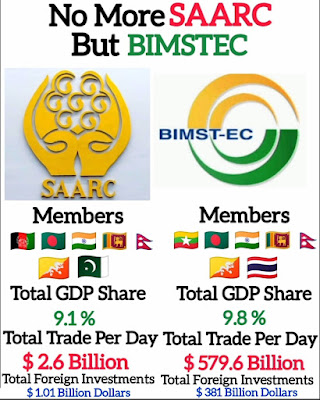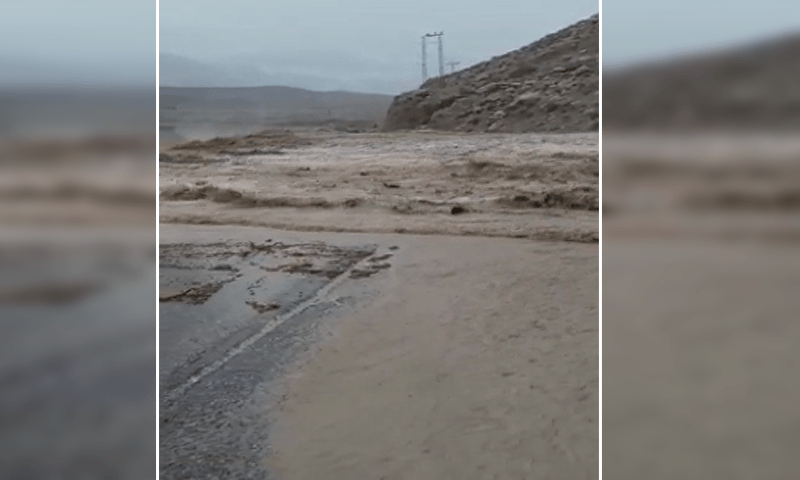BIMSTEC as key to a new South Asian regional order
December 8 is commemorated as SAARC Charter Day. It was on this day, 37 years ago, that the South Asian Association for Regional Cooperation (SAARC), an intergovernmental organisation, was established by Bangladesh, Bhutan, India, the Maldives, Nepal, Pakistan and Sri Lanka to promote economic growth in South Asia.
Pakistan has adopted an obstructionist attitude within SAARC by repeatedly blocking several vital important Agreements.
What is BIMSTEC?
The Bay of Bengal Initiative for Multi-Sectoral Technical and Economic Cooperation (BIMSTEC) is a multilateral regional organisation established with the aim of accelerating shared growth and cooperation between littoral and adjacent countries in the Bay of Bengal region.
It has a total of seven member countries- five from South Asia, including Bangladesh, Bhutan, India, Nepal, and Sri Lanka, and two from Southeast Asia, including Myanmar and Thailand.
It was founded as BIST-EC, in June 1997, with the adoption of the Bangkok Declaration, with Bangladesh, India, Sri Lanka and Thailand as members. It became BIMST-EC (Bangladesh, India, Myanmar, Sri Lanka and Thailand Economic Cooperation) with the entry of Myanmar in late 1997, And eventually, it was named in its current form, when Nepal and Bhutan became members in 2004.
The Bay of Bengal region, was one of the world’s most integrated regions until the early twentieth century, according to a 2020 research paper by Constantino Xavier and Riya Sinha for the Vivekananda International Foundation. But after the 1940s, when members of the region became independent and pursued separate goals and alliance systems, “the region’s sense of community has almost completely eroded.”
So, the aim of setting up the regional grouping was not to create a new region for cooperation but to revive the connectivity and common interests of the members of the Bay of Bengal region. BIMSTEC’s first Secretary General, Sumith Nakandala, echoed this when he had said, “we are not reinventing the wheel” but just “rediscovering the common heritage around the Bay of Bengal.”
According to the official website of BIMSTEC, “the regional group constitutes a bridge between South and South East Asia and represents a reinforcement of relations among these countries.”
What makes BIMSTEC different from other regional groupings such as SAARC or ASEAN is that it is a sector-driven organisation. This means the goals or areas of cooperation are divided between members, for instance, out of the multiple sectors like trade, energy, transport, fishery, security, culture, tourism and so on, India was made responsible for areas like transportation, tourism and Counter-Terrorism earleir.
However, the Ministry of External said that during the current summit, members decided on a complete reorganisation of cooperation activities to streamline them into seven pillars, as opposed to the earlier bifurcation of 14 sectors. It further stated that India will be BIMSTEC's pillar for security; this will include areas of counter Terrorism and Transnational Crime (CTTCC) Disaster Management and Energy.
What is the working mechanism of BIMSTEC?
Until the current summit, BIMSTEC did not have a formal document or organisational architecture, which was adopted this time in the form of the BIMSTEC Charter.
However, it did have a working mechanism for policy making and operational goals. Policy making would be done through two types of meetings: Summits, which are supposed to be held every two years; and ministerial meetings of Foreign and Commerce Ministers of member countries for deciding on trade and economic affairs, to be held once every year. An operational meeting of senior officials to monitor the activities of the grouping is also supposed to be held twice a year.
Since its inception, BIMSTEC’s policy making meetings have not been held as per plan. Just five summits, including the current one, have been held in 25 years. Meanwhile, 18 ministerial meets have taken place so far; and between 2014 and 2017, the Senior Officials meet was postponed seven times.
BIMSTEC didn’t have an official headquarters or secretariat until 2011 and 2014 respectively when the headquarters were established in Dhaka and its first Secretary General — Sri Lankan diplomat Sumith Nakandala was appointed.
BIMSTEC has a coordinating body called the BIMSTEC Working Group, which has a rotating chairman based on which member country chairs the organisation (the current Chair of BIMSTEC is Sri Lanka). Under this, meetings are to be held monthly at the Dhaka secretariat to review the progress of the regional grouping.
What is the significance of BIMSTEC?
The BIMSTEC region hosts 22% of the world population or 1.68 billion people; and the member states have a combined GDP of US$3.697 trillion/per year.
For India, BIMSTEC aligns with its ‘Act East’ policy for greater regional cooperation in southeast Asia. It could also be seen as aligning with India’s larger goal to gain trade and security prominence in the Indian Ocean region and to cater to the concept of the ‘Indo-Pacific’ region, a major focus of Quad countries.
A 2021 research series of the Observer Research Foundation indicates what’s in it for other member countries to be a part of a grouping focused in the Bay of Bengal. It says that for Bangladesh, BIMSTEC might be a platform to strengthen its much-needed economic development, while Sri Lanka sees the goal of becoming a hub for shipment in the Indo-Pacific region. For smaller members Nepal and Bhutan — the two landlocked, mountainous states — the grouping serves as a pass to the sea. Lastly, for Myanmar and Thailand, it could be seen as a way to reduce over-dependence on China and as an opening to a huge consumer market for its commodities.
Another important factor for India in becoming a prominent leader in the Bay and maintaining peace and security, is China making inroads in the Indian Ocean Region over the years. Besides, China today is involved in a widespread drive to build infrastructure in South and Southeast Asian countries, it has projects under its Belt and Road Initiative (BRI) in all BIMSTEC members except India and Bhutan.
The idea of BIMSTEC also gained prominence after the 2016 Uri attack when India was able to get SAARC (South Asian Association for Regional Cooperation) nations on its side to boycott the organisations’ summit, which was to be held in Islamabad, Pakistan. The progress of SAARC has stalled over the years due to Indo-Pak relations and what experts call Pakistan’s obstructionist approach to the organisation. BIMSTEC emerged as an alternative platform for cooperation. In the 2014 SAARC summit, Prime Minister Modi called for more shared infrastructure and connectivity in South Asia, and said in an indirect reference to Pakistan: “Those who want to come with us, welcome and those who do not, the rest of us will continue.” India had also invited BIMSTEC heads of state for Mr. Modi’s swearing-in ceremony in 2019.
In this context, India also made efforts to enhance the pace of BIMSTEC’s progress in recent years. The BIMSTEC Energy Centre was set up in Bengaluru, along with the BIMSTEC Business Council, a forum for business organisations to promote regional trade. It aims to create free-trade and power grid interconnectivity agreements, and a masterplan for transport connectivity in the Bay of Bengal region (adopted at the current summit).
And lastly, BIMSTEC is important owing to the land and maritime trade potential of the member countries.



Comments
Post a Comment